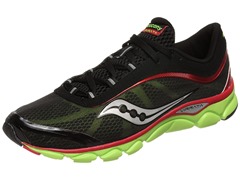 Several weeks ago I travelled a bit over an hour south from my home in New Hampshire to visit Saucony headquarters in Lexington, Massachusetts. The purpose of my visit was twofold. First, I wanted to visit their biomechanics lab and have my form analyzed using their gait analysis setup (force plate treadmill, 3d kinematics – very cool!). Second, I wanted to meet their design team and get a tour of their facilities.
Several weeks ago I travelled a bit over an hour south from my home in New Hampshire to visit Saucony headquarters in Lexington, Massachusetts. The purpose of my visit was twofold. First, I wanted to visit their biomechanics lab and have my form analyzed using their gait analysis setup (force plate treadmill, 3d kinematics – very cool!). Second, I wanted to meet their design team and get a tour of their facilities.
I arrived at Saucony HQ just before the official release of their new zero drop shoe, the Saucony Virrata. Given my past success with Saucony shoes (Kinvara, A5, etc.), I was really excited about the Virrata and was looking forward to getting ahold of a pair. When I arrived I was told that I’d be able to run in their gait lab in the Virrata, and take a pair home with me – for a guy with my interests, this is like a kid walking into a candy store and being given the biggest lolliop in sight!
I have a lot more to say about my experience that day (lots of data and videos from the lab), but what I’m going to focus on here is a review of the Virrata. I’ve now put over 50 miles on them, and they’ve quickly become one of my favorite shoes.
The Virrata is not Saucony’s first foray into the zero drop niche. They released the Hattori a few years back, but it never really caught on in a big way, and based on my conversations with the Saucony team its future in their lineup is in limbo (personally, I like the Hattori, but some aspects of its design prevent me from running in it beyond a few miles). With the Virrata, Saucony was hoping to create what essentially amounts to a zero drop shoe built in the mold of the popular Kinvara. In other words, they weren’t trying to make a “barefoot-style” shoe here. Rather, the intent was for the Virrata to serve as a well cushioned shoe for those who don’t like any heel lift.
Before getting into the nitty-gritty details of how the shoe performs, I wanted to address a bit of a controversy about the Virrata. When Runner’s World reviewed the shoe they reported it to be a 4mm drop shoe (24.6mm heel, 20.6mm forefoot to be exact). I’ve heard a few other people comment that it doesn’t feel zero drop. I asked Saucony about this and they were rather perplexed by how those Runner’s World measurements were obtained, and assured me that the shoe is in fact zero drop (I’m hoping to get a photo of a sliced shoe from them as proof Saucony provided me with a photo of a longitudinal sole section showing that the sole is level from the heel to the region of the metatarsal heads). Running Warehouse reports the Virrata as being 17mm heel, 17mm forefoot. I used my trusty C-calipers and also measured it as 17mm heel, 17mm forefoot (insole included). Given this, I’m confident that the shoe is in fact zero drop, and I’m also now a bit confused about the measurements reported by Runner’s World (Update: In talking with Runner’s World the discrepancy seems to be due to differences in the locations where sole thickness measurements are taken).
As I mentioned above, I’ve now put a bit over 50 miles on the Virrata. I’ve used it for easy runs and speed, and have run as long as 13 miles in one go in them. It has performed well in all situations. Below are my more detailed thoughts:
Upper
The upper of the Virrata is very reminiscent of that on the Kinvara v2. It’s composed of an outer layer of monofilament-style mesh, and an innner layer of soft fabric. When I first saw the shoe I was a little worried that the outer mesh might be prone to tearing as has been reported in the Kinvara v2, but Saucony told me that it’s not the same material and that it should hold up better. I have not had any issues with the upper on my pair yet.
In terms of fit, the Virrata initially felt snugger in the forefoot to me compared to the Kinvara. After wearing the first pair I was given around for a few days, I came to the conclusion that the shoe fit just a tad short, and that going up a half size might make for a better fit. I gave my size 10’s away and asked Saucony if they could replace them with a pair of 10.5s. It made all the difference in the world! I now feel like the fit is pretty similar to the Kinvara in a half size smaller, and I don’t feel like the Virrata is overly constrictive. I haven’t tried running sockless in the Virrata yet, but the interior feels like it might be suitable for sockless running.
Sole
Sizing up in the Virrata had an unexpected consequence with regard to the feel of the sole underfoot. When I first put my original pair on I felt like the sole of the forefoot thinned out rather abruptly up front, almost making me feel like I wanted to roll forward in the shoes. Part of me wonders if this is why some people say it doesn’t feel zero drop. However, after sizing up that feeling is gone. I think the issue has to do with the podded design of the sole cushioning.
If you look at the photo above, you’ll notice the distinct bands of triangular cushioning pods that cross the sole. The band directly across the center of the forefoot is the same thickness as the heel (17mm), and should sit right under your metatarsal heads. I think in the size 10 my met heads were a bit more toward the front of this band, which accentuated the feeling of the sole thinning out up front (and maybe why some say it doesn’t feel zero drop). When I went up to the size 10.5, I could feel that the pod row was now in a better place, and the forefoot cushioning felt much better. In fact, with the fit correct I might go so far as to say that the Virrata has the best forefoot cushioning of any shoe I have worn.
The sole of the Virrata is pretty soft, so those who like a firm shoe should look elsewhere. But, if you like the Kinvara and you want a zero drop alternative, or if you’re just looking for a well-cushioned zero drop shoe, the Virrata is definitely worth a look.
Another benefit of the podded sole design is that the forefoot of the Virrata is quite flexible – I’d say it’s a bit more flexible than the Kinvara. A drawback of the pods is that I suspect durability will be a problem for some runners, particularly those who chew up the lateral forefoot of the Kinvara. Because the pods extend down from the sole, I suspect they might wear down faster than a more uniformly flat sole design.
Saucony chose to use rubber very sparingly on the sole of the Virrata (likely to spare weight – the Virrata is listed at only 6.7oz in a size 9) – there is a patch on the heel, and a bit under the big toe and tip of the forefoot. The rest of the sole is exposed EVA, so again a cause for concern if you have a history of accelerated sole wear on your shoes. I will say that after 50-60 miles my sole wear is pretty minimal, but I tend to not destroy soles badly.
Conclusion
I’ve really enjoyed running in the Saucony Virrata over the past few months. As a fan of the Kinvara, this shoe feels like a close, zero drop cousin with better cushioning under the forefoot. All good things. Perhaps the most complimentary thing I can say is that the Virrata remains in contention to be my Spring marathon shoe – it’s probably a close second to the Skechers GoRun 2 for that honor with two months to go.
At an MSRP of $89.99, the Virrata is actually a pretty reasonably priced shoe, though cost per miles run (i.e., durability) will vary highly depending on how your mechanics work with the sole of this shoe. Given the current condition of my shoes, I’d say that they should be comparable to the Kinvara in terms of durability.
If you’re in the market for a well cushioned, zero drop shoe that is not overly roomy up front, the Virrata is the shoe for you. If you want all of those things and a wide forefoot, look to the Altra Torin. Both are great options in the cushioned, zero drop niche!
Outside of the US, the Saucony Virrata can be purchased at Wiggle.
In the US, you can purchase the Saucony Virrata in several color combinations (see below)at Running Warehouse.
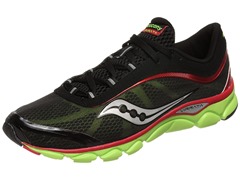 |
 |
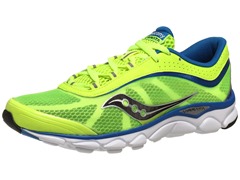 |
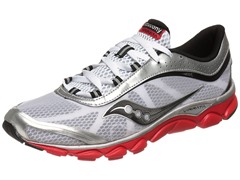 |
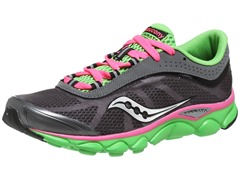 |
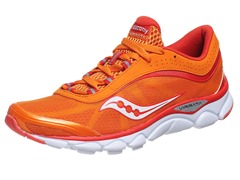 |
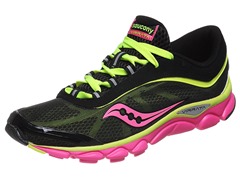 |
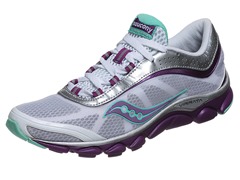 |

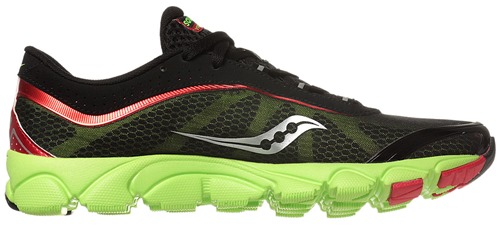
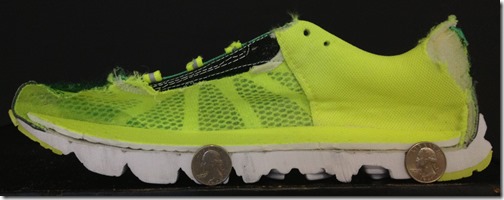
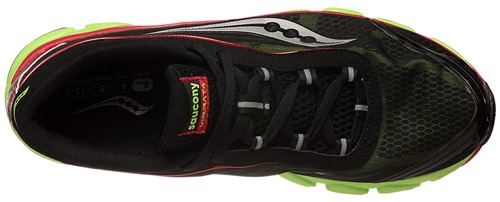


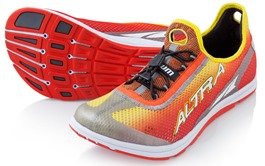
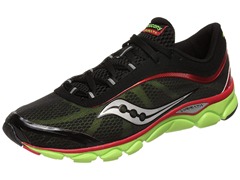

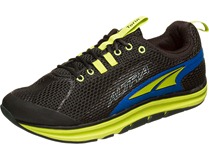














Nice review Pete! I might have to give the Virrata’s a go later in the spring. I’ll see how my Cursoris wear over the coming weeks. If the Virrata’s are a bit narrower than the Kinvara’s, I will also likely have to upsize. The K3’s tended to be slightly tight in the outer forefoot for me.
BTW, any plans to review the Cursoris? I would be interested in your comparison between these two shoes, if it is in your plans.
Yeah, I have a pair of Cursoris waiting for me at a friend’s house, just need to meet up with him for a run so I can pick them up!
—-
Pete Larson’s Web Links:
-My book: Tread Lightly: link to ow.ly
-Blog: https://runblogger.com
-Twitter: link to twitter.com
-Facebook Page: link to facebook.com…
-Discussion Forum: https://runblogger.com/forum
Great! Looking forward to your comments after you put some miles on them.
Also, I forgot to ask earlier. With Saucony and Merrell owned by the same parent company, were you able to divine any indication of any cross-pollination going on or are they pretty well staying at arms length from each other?
The acquisition is still pretty new, not a lot of interaction yet as best I can tell.
—-
Pete Larson’s Web Links:
-My book: Tread Lightly: link to ow.ly
-Blog: https://runblogger.com
-Twitter: link to twitter.com
-Facebook Page: link to facebook.com…
-Discussion Forum: https://runblogger.com/forum
Do these shoes provide more cushion than brooks pure flow? Im in Kinvara 3s and they feel great but I need more cushion under strike. Thanks
The Flows have a different kind of feel. The Virrata is pretty soft, and has great forefoot cushioning, but heel not too different from the Kinvara. The Flow has a springer feel since the sole is made of a different compound.
Sent from my iPad
thank you. I ended up over doing it with my Kinvara 3’s and ended up with a sore metatarsal area (underfoot) I’ve only been in these shoes for a couple months. Really love the feel and fit but am thinking I may need more cushion beneath strike area? Sounds like the Viratta and flow are worth trying. Would you put the Skechers that you are considering wearing in VT. Marathon in this same category? Thanks again for your help!
Yes, the I use the Skechers for similar running situations as the Kinvara and Virrata. They also make the GoRun Ride which is even more cushioned
Sent from my iPad
Ok,
Now I want to try the GoRun ride as well! Does it provide more cushion than the rest? This could be an expensive spring for me –
Thanks again.
If you can still find a pair of the Flow version 1 it has the same sole as the update and you might be able to find it cheaper. I don’t recall the dimensions of the sole of the Ride, but it’s pretty well cushioned.
Sent from my iPad
Just bought a copy of your book. Thanks again for the help.
Thank you!
I’m wearing Flows right now. Got them today. Still have some metatarsel soreness (day 3). Seems to be improving. Hoping to run again on Sunday. Prior to bruising metatarsel area I had been having my best winter/spring training. Only been running for a few seasons and just switched over to Kinvarna 3 a few months ago. All my running prior to that was in Asics that had high arch support. This is my first running related injury. I run light on feet. I think injury resulted from jumping in high skip during training? Anyway, the Flows do provide more cushion at point of contact than the Kinvara 3. I’ll soon see whether or. Not they feel as good on long run. Typing on IPhone is rough!
Thanks again for help and advice. I’m planning on ordering the ride for $50 as well.
Good luck, hope all goes well!
Sent from my iPad
Yes, thanks. What doesn’t kill your running life only makes it stronger!
Thanks Pete,
I love My new Vitarra’s and now I’m gonna try the skechers you suggest. I think I’m gonna buy a second pair of Vitarra to keep fresh treads/soles for races as I plan to train in them as well.
For the Go Run Ride, the cushion is 12 mm forefoot, 19 mm midfoot and 16 mm at the heel so it’s a 4 mm drop with a wide toe box and nice feel…and you can buy them for around 50$ on amazon so it’s a good deal for a very decent shoe.
Thank you Pete! I’m going to get myself a pair of these Viratta’s as well as Flows to try out.
Was very excited for these, but I’m one of those guys who tears up the EVA on my Kinvaras very quickly (right behind my little toe). I’d be fine with another 2oz of weight to get some rubber on each of those triangles.
Scott,
I actually talked to Saucony about that lateral forefoot issue. They’d contemplated adding some to the outer forefoot of the Kinvara, but were afraid it would alter the feel underfoot. Their sense from their testers is that the forefoot issue is a problem for some, but that it’s a pretty small segment of Kinvara users, and they’re afraid of messing with the ride for those who love the shoe and don’t tear it up. As you might expect, any change to an extremely popular shoe will be met with praise from some, derision from others. Guess it’s a cost to the many vs. benefit for the few type thing. Maybe they should just make two versions of the shoe!
Pete
—-
Pete Larson’s Web Links:
-My book: Tread Lightly: link to ow.ly
-Blog: https://runblogger.com
-Twitter: link to twitter.com
-Facebook Page: link to facebook.com…
-Discussion Forum: https://runblogger.com/forum
I too had to exchange for half a size larger, and then they felt better. I was surprised though, that even though they have more cushioning, they didn’t feel more “cushy” under the forefoot. I’m going to be putting a bit more mileage on them, and probably wear them for my races this summer if all goes well… Thanks for the awesome review!
Peter, you could inquire rather than simply claim that we’re wrong. I’d happily explain our testing process in the RW Shoe Lab. It’s significantly more precise than a caliper. In short, we always measure a men’s 9 and women’s 7, measuring in specific locations using a standard protocol so there are repeatable, reliable results between different operators on different days, and can be replicated in a different lab. Often, folks either report midsole specs (which rarely correspond to final product), or measure in different locations. I’m confident in the measurements made.
I disagree. Calipers are pretty darned accurate, and my numbers match what Saucony reports, as well as what Running Warehouse reports. The only way I see this a 4mm drop shoe is if you measured it further up on the forefoot. Where exactly are your measurement locations? I often find discrepancies with numbers you guys report.
—-
Pete Larson’s Web Links:
-My book: Tread Lightly: link to ow.ly
-Blog: https://runblogger.com
-Twitter: link to twitter.com
-Facebook Page: link to facebook.com…
-Discussion Forum: https://runblogger.com/forum
I’m with you Pete, I don’t measure, but these are flat unless you move into the tapered area beyond the metatarsals. That said the taper makes them easier to run in for me than other zero drop shoes. I’ve also run in the Virrata with a 4mm heel raise and they feel great. Hopefully the next Kinvara feels the same!
Another shoe I need to add to my collection! You seem to have similar taste in shoes as I do, so it’s nice to read you like the Virrata. I’m a huge fan of the Kinvara, as well as the Torin and it sounds like the Virrata will be a nice option.
I am loving my virrata’s :O ! I find them a tad wider in the toe than the Kinvara 3’s but narrower than my Flow 1’s. I have about 35 miles on them. I did notice that my stride rate went from 160 on average to 168 in the Virrata’s. Like Pete said, much softer forefoot cushioning than Kinvara. Compared to the flows, they feel faster and less marshmellowy. They disappear on my feet.
Interesting! you actually find them bit wider forefoot than the Kinvaras? That sounds awesome!
Yes from what I have read and experienced, everyone should try this shoe on. Some think it is narrower some wider than the kinvara. The sole of the shoe is narrower than the kinvara but it rises straight up whereas the kinvara tapers upward and to me appears to be narrower at the foot bed.
Hi Pete
I’ve been running in the A4 and the A5 for the last 2 years, and think they are the most comfortable shoes I’ve ever run in. Landing and toeing off are so soft and fluid, that the soles seem like cat’s paws- if you know what I mean. Do you think the Virratas or the GoRun 2 will give the same feeling (as if the sole is “glued” to your foot and moves with it)?
I am not Pete, but I have experiences with both the Virrata – guest review here :) – as the A5. I would say the feel of the sole is totally different. Do not expect the same gluey feeling with the Virratas. I personally experience that great gluey feeling in the A5s the most when the sole is in contact with the ground. I think it is because the A5 sole is rather low and very flat. The Virrata sole is higher and far less flat.
I am curious what Mr. Larsons opinion is though.
Thanks for your input. Glad to find someone besides me who also feels and appreciates the “gluey” feeling of the A4 and A5. Do you know if the GoRun 2 gives the same feeling?
No I can not help you, I have never seen any GoRuns in real life… But the GoRun 2 sole does not look like a racing flat (a5) sole. Pete is the one you want to talk to about GoRuns!
The GoRun has a soft sole like the Virrata, and it’s geometry is quite different being a little thicker in the middle than in the heel or forefoot. One of the cool things I got to see in the Saucony lab was that although I tend to contact with a slight heel strike, my foot pressure tracing is localized initially in the midfoot at contact and then moves foreword, so I don’t put a lot of pressure on my heels even though I’d be classified as a heel striker on video in most instances. I’m wondering if this is why the GoRuns work so well for me since they are built to be most cushioned in the midfoot.
Sent from my iPad
If both the A5 and the GoRun 2 have an identical drop – 4 m – and their sole height/thickness is nearly the same – doesn’t it follow that both will give the same feeling I’m looking for (the “glued” feeling)?
The difference is that the A5 is 4mm and smoothly tapers from heel to forefoot. The GoRun gets thicker from heel to midfoot, then tapers quickly to the forefoot. So the geometry is different in the midfoot region. It has a more rocketed sole design.
Sent from my iPad
It’s definitely a different feel, but good nonetheless. I find the Virrata much softer in the forefoot. It may also be related to the lack of the grippy outsole on Virrata like that on the A5.
Sent from my iPad
I’d put both among my favorite shoes to run in along with the A5, but they do each have a unique feel that is a bit different. I’d say they all fit that category of disappearing on my feet.
Sent from my iPad
Great review Pete, I can see you are the professional.
I have now run 144 miles in the Virratas, with two long runs of 21 and 22 miles. They still feel good. A few remarks:
– My toes feel (even) better after long runs in the Virrata than in long Kinvara runs. These days I run all my long runs in my Virrata, as I expect to wear them in the Rotterdam marathon April 14th;
– I think I would have to agree that the durability is just a bit less compared to the Kinvaras, but I am not sure. I run 600 miles in Kinvaras, I expect to make 500 plus in these. I will let you know in a few months. This is by the way the first shoe where I can see most of the wear on the sole around my ball of foot, and hardly any on the back of the sole! Whereas I did have more wear on the back of my soles at Kinvaras and Nike Free 3.0s;
– I did not have to size up. Same size Virrata as Kinvara, whereas my A5s are half a size bigger;
– On my last long run I did get a sour ball of left foot, but I do not think the shoe is to blame. It might be just the added miles, I have never run so many weeks so many miles;
– Last remark: only one colour available in the Netherlands. This is so unfair!
As I said, at this time my pick for the coming marathon. A5s are a dangerous outsider.
Thanks for the update, forgot to link your review here as well, will add it in. Great to hear you may get 500 miles out if them, would make them a real bargain!
Sent from my iPad
My guest post still is a highlight of 2013 to me! Thanks
Just today I brought them to 500 miles. I think they are close to retirement. Sole is pretty much worn and around my big toes the inner layer on top is ripped loose from the outer layer. I expect to get my second pair of Virratas, in my favorite color scheme, next weekend. And I am confident enough to use them one week later in a marathon right away.
500 mils is pretty solid for a shoe at this price point!
Sent from my iPad
Last Sunday my brand new Virratas brought me to a new PB in the Loch Ness marathon. With just a few miles in them I ran without any pains 3.14’52. Great shoes!
Congrats!
Sent from my iPad
hi pete – thanks for these insights! i still have my original (v1) kinvaras in rotation, and when i heard about the virratas i was quite excited at the possibility of taking them on as a new race day shoe. i did try them on at the local sports retailer, but ended up opting for the skechers gobionics because of stack height and ground feel. how would you compare the two?
The Bionics are firmer, more flexible, and have a wider toebox. Pretty different feel.
—-
Pete Larson’s Web Links:
-My book: Tread Lightly: link to ow.ly
-Blog: https://runblogger.com
-Twitter: link to twitter.com
-Facebook Page: link to facebook.com…
-Discussion Forum: https://runblogger.com/forum
Your reviews are always so helpful! What a fun “field trip” to Saucony. After a brief foray into the Brooks Pure Connect I may return to the Saucony Kinvara or possibly the Virrata. The Conncets proved to be too cushioned and were causing some discomfort in the big toe of my right foot; I think I was causing pronation in my right foot. I’ve concluded I like a shoe with a firmer ride. How much more cushioned is it than the Kinvara3, which feels pretty firm to me?
Definitely feels softer to me than the Kinvara, mainly in the forefoot. The Connects are also pretty narrow, so wonder if that might have something to do with it?
Sent from my iPad
I though I liked the snug fit, but it could have been forcing my foot into an unfamiliar position. I wound up with turf toe/tendonitis type stuff in the joint of the big toe. It went away with rest. I got the Saucony Fastwitch and have worn that for a few runs and really like it.
I just tried out the shoe today. Thanks much for the heads up about the sizing. I wasn’t able to try out the shoe in one size higher yet, but I also felt the bump around the metatarsals in my normal size. What I didn’t expect was that I’d like the shoe so much. If the half size up feels good, I may have a decision to make between these and my Sketchers Go Run Rides for my spring marathon. Oh, and for me, I strongly preferred both shoes to the Mizuno Evo Cursoris (too narrow a platform and fatiguing for me).
I had high hopes for this shoe, but unfortunately can’t get a good fit. The toe box is too tapered. I tried different sizes today, and to get the big toe to fit comfortably without rubbing, I had to size up a full size, and then I would have a lot of empty space in the tapered tip which feels and looks weird. I wonder why they didn’t design a rounder toe box in a shoe meant for natural running. Such as in the Mizuno Evos or Altras.
Pete, love your reviews! Been running in Merrells the past year and will be giving these a go !
Thanks Mike!
Sent from my iPad
Thanks for another great review Pete. How different, or similar, are the Virattas compared to the Altra Instinct 1,5, in terms of their ride and fit?
Narrower and softer, very different shoe. Can you get them where you are?
Sent from my iPad
The Virratas are not here yet (in Indonesia) but they should be soon. I’m currently liking the Altra Torin, and, surprisingly, those Spiras are growing on me. Thanks again for a great review.
Any idea is Saucony plan on making a 2E Virrata like they do for the Kinvara 3 ? Also a question in general regarding 2E sizes, usually is it just the toe box that’s bigger on a 2E or that’s the whole shoe that’s larger everywhere ? In general I like the wide toe box and Kinvaras and Virratas are too narrow for me but I still want a secure fit around angle and arch. Altra makes a great shape in that sense but appart I’m not a huge find of how their shoes ride (too stiff for me)… Thanks for any information you can share on future 2E developments…
Not sure on the Virrata in 2E, my guess would be it depends on how well it sells if they decide to add widths. My understanding of 2E is that the entire shoe is wider, not just the forefoot. As for Altra, check out their new shoe The One, lighter and more flexible.
Sent from my iPad
Nice review, i like this shoe. Could be wider for my toes. But light and flexible. You should try la sportiva helios, a bit heavier, but wider toebox. Going to be my choice for the first marathon.
Great shoes indeed! My favourite!
Black & orange were not available in Europe, so I had them shipped via a friend.
I did some work-outs, ran a 25 km and last week-end an olympic distance tritahlon… so very few number of km (I would say around 70) and indeed they are worn-out on the outer forefoot… not normal. It is a passion killer. Will there be a new release with some more robust spots (some more grams will not kill the great feeling I have in those shoes).
Not sure if they’ll build up that area, I suspect not since they have not done so with the Kinvara. Wear is highly variable, have about 100 miles on mine and they still look pretty good.
Berliner asphalt must be very rough then :)
I don’t know if i can compare the material with the Newton Distance (they seem to look the same) but I have put more than 500 miles on those shoes (same roads, maybe sometimes snowy, same runner, same wait) and they have the same wear and tear as the Virrata. Anyways…
Keep up the good job, i really enjoy reading your blog.
Distance has rubber, whereas the Virrata is exposed EVA foam. Wear depends on how your foot moves relative to the ground at contact and toe off
I love the Virratas. I’ve been able to put 200 miles on them with no problem, but I wish they could improve on the sole design so that it’s not as susceptible to wear. They use the podded design to add flexibility and the “piston-effect” that supposedly helps you move forward, however, I wonder if there any real evidences to support that claim. I think removing the pods and having an outsole design similar Nike Free would help durability while still preserving the flexibility.
I bought and had 2 training runs, a 10 mile race and Grandma’s Marathon in them for roughly 50 miles on the shoes. I then wear them for a half marathon and 5 miles in I notice the mesh overlay had torn above the logo. Took them back to the store and got them replaced. I was expecting too much out of the shoe since I only get about 350 from Kinvaras, but I never expected the upper to fall apart that fast. Hopefully the replacements last a little longer.
I was a bit worried about that mesh, but 100 miles on mine and have not had an issue. Hopefully the replacement will hold up better.
Sent from my iPad
I bought the Virrata based on Pete’s review…LOVE IT, period. Granted, I haven’t run in zero drop shoe in a while, which made the first run extremely painful. It took me 4 10-mile runs to make the adjustment, and the last run was great. The shoe provides a very reasonable mix of cushion and responsiveness, and it is more than a full oz lighter than Kinvara 4 (I like K2, but K3/4 just weren’t my cut of tea). Before I bought it, I was a bit concerned that the shoe was too narrow, but in fact it has good toe room. I see the Virrata 2 is coming out soon, hope Pete will give a quick sneak view, and Saucony won’t screw this one up ~~!
One definite problem with longevity: look at the lacing. There are several sewn-in loops, fine, and the last two eyelets are reinforced. For some unbelievable reason the third eyelet, last one before the loops, is *not* reinforced (the liner reinforcement stops at the edge of the eyelet!) and it ripped through with 175 miles on the shoes. I really, really hope Saucony fixes this next season since otherwise I love the shoes, but that just ain’t enough mileage.
I love the Saucony A5, also enjoying my Altra Intuition at the moment and don’t really *need* another shoe right now, but thinking I’m going to add the Virrata to my rotation. The original version is down to $60 on Running Warehouse with another 15% from my running club. Thinking it is worth a try for the price. So little time, so many shoes to try!! :)
Can’t beat that price! Also saw the Virrata at my local Marshall’s store for under $50.
I know this comment is way, way late, but thank you for writing this, now almost a year later! Runner’s World recently released their Spring Shoe Guide 2014 and marked the Saucony Mirage 4 at 8.3 mm while Saucony advertises the Mirage 4 as a 4mm drop… I’m still perplexed at such a marked difference, but I’ll take your word for it! Thanks again!
Runner’s World measures at defined points along shoe length, which seem further back and farther forward toward the toe tip. Shoes thin out near the tip and I think this is the reason for the discrepancy. Running Warehouse and I measure at center of heel and under the forefoot.
I really enjoy my Virratas, but I believe they are ever so slightly too narrow. On long runs, I will blister on the center of the ball of my foot.
Is the Virrata 2 any wider? I have the same problem with my GoRun2.
The best fit seems to be my Altra Torins. I have also orders the Skecher GRR3, because I hear it is a little wider in the toe box.
Thanks!
Rob
I just tried on the Virrata 2, fits me fine, but I’d be hard pressed to say it’s wider. The interior does feel softer. I went a half size up and it solved the narrowness issue for me.
Hi pete,
How you compare virrata vs wave sayonara?
Thanks.
Totally different shoes. The Sayonara is very firm, 8-9mm drop, roomy toebox. Virrata is soft, great forefoot cushion, zero drop, fairly narrow toebox.
Great review. Thanks!
I’m looking for a light and “natural” shoe and the Virrata seems very interesting.
In the past I’ve run in the Pure Flow and found it great for my long runs. The only problem was that I did not feel confident with the grip of the sole when not on dry, paved road. After a couple of risky drifts on steep paths in a city park, I’ve moved the Flow to my seaside house for rides on flat roads.
Can you tell me if the Virrata have a good grip also on wet road and on the unpaved paths in city parks?
Thanks a lot
Andrea
I ran a marathon in the rain in the Virrata and they worked fine in those conditions, my guess is they’d be ok on unpaved paths as well.
No, no, no, no. Whilst the running industry continues to classify these, and other similar shoes, as “zero drop”, and everyone else falls in line, we will never ever get a proper (cushioned) zero drop shoe – something I have been waiting for, for many years. To clarify: Zero drop should be the same thickness of cushioning throughout the entire shoe, meaning from heel to toe, NOT heel to forefoot only. Think about it: you are stood naked, your heel is on the floor, the ball of the foot is on the floor, and your toe is ALSO touching the floor. THIS is zero drop – the entire foot being the same distance from the floor.
Pete –
Hope you are doing great. Quick question. I love the forefoot cushioning (and everything) about Virrata. I heard they are being discontinued :( Is there another shoe which might be comparable?
(I’ve already tried Newton, Kinvara, Cortana, HOKA) Thanks so much!
Try the Altra The One 2.5.
Pete: Thanks so much for the advice! I appreciate it, always! Sarah